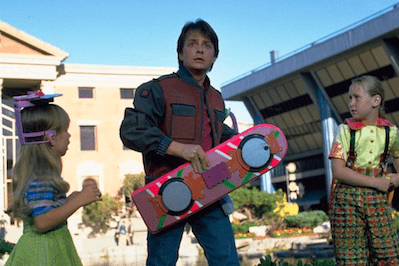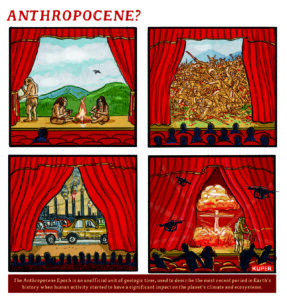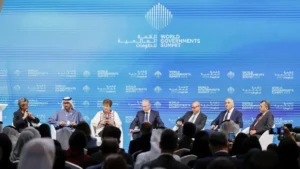A Future That Didn’t Deliver
Fans of “Back to the Future II” anticipated a world of hoverboards and flying cars, where the only thing warming was the roast in the food replicator. But an apocalyptic 1985 ruled by the eerily Trump-like Biff most resembles our actual present. Michael J. Fox in "Back to the Future Part II." (Universal Studios)
Michael J. Fox in "Back to the Future Part II." (Universal Studios)
By Hal Niedzviecki
For fans of one of the most beloved hit movies of all time, today is monumental. As “Back to the Future” enthusiasts have been pointing out for at least the last year, Oct. 21, 2015, is the day Marty McFly rides Doc Brown’s DeLorean-turned-time-machine 30 years into the future.
The vision of the future depicted in 1989’s “Back to the Future Part II” (“BTF2”) has become iconic. McFly lands in a world that looks pretty much like the ’80s, only with way cooler stuff. Kids ride hoverboards, adults drive flying cars and everybody enjoys insta-pizza and something called Perfect Pepsi. There’s even a “weather service” that doesn’t just accurately predict, but entirely controls when and for how long it’s going to rain.
Naturally, today will be the day for a thousand billion bloggers to compare this better future to our actual present/future. Cue the click-bait slideshows. They promised us flying cars, goes the now familiar refrain, but instead we got Facebook. “Rapper Wiz Khalifa was arrested at LAX this week,” writes a Gizmodo blogger “What was he arrested for? If we’re to believe almost every headline, Wiz’s crime was joyriding a hoverboard at the airport. Are we finally living in the future Back To The Future II promised us?”
And so we arrive at a kind of “Back to the Future” nostalgia in which we yearn for a future—a 2015—that, we bizarrely lament, has failed to arrive. It wasn’t supposed to be this way. By now, robots should be doing all the work, though somehow we should still all have jobs and purpose; the nuclear family should be as it was in the McFly ’50s (a golden age of nuclear) and the only thing warming on our planet should be the roast in the food replicator.
There’s a serious side to all this pining for a future that never arrived. Our nostalgia has morphed into longing and even obsession. In ongoing defiance of our reality, we not only still believe in the “BTF2” future, we’re still trying to get to it. A Pew Research Center survey this year showed that “19% of Americans think humans will be able to control the weather in the next 50 years.” A commentator sums up the Pew results this way: “People are pretty certain we are about to start living inside a futuristic Hollywood movie.” Then there’s the just-released Model X all-electric SUV by Tesla Motors. “It’s like a car from the future,” proclaims CEO Elon Musk. It certainly is—the future 2015 as depicted 26 years earlier. From the standpoint of the present, however, it may be worth asking what it means to portray a $132,000 car complete with—yes!—upswinging, DeLorean-style doors as the future of humanity.
Tesla is only giving us what we want. After all, in the bizarre future/present we actually live in, the luxury SUV market is the hottest automotive category in the U.S., with sales five times better than the industry as a whole. We’re in a golden age, all right—the golden age of climate change denial. In 2015 “BTF2” style, those who can afford high-end vehicles “from the future” get to act out the collective fantasy in which we can have it all, enjoying total comfort as we roll along a treadmill of accelerating consumption that has zero consequences for the environment and social fabric. The rest of us get to admire the one-percenters while waiting our turn in the form of, say, the arrival of a more affordable Tesla car—all the futurity at half the price.
I’m picking on Tesla, but I could be using just about any tech company as an example. Apple, Twitter, Samsung, even Lexus (makers of a “real” hoverboard, though it’s not for sale)—all perpetuate the fantasy, promising a cocoon of futuristic technologies that can protect us from the present by bringing about a future that looks like the past. No DeLorean necessary.
In “BTF2,” McFly and company return from 2015 only to find the 1985 from which they’d departed horrifically changed, the fictional all-American town of Hill Valley now controlled by the repugnant Biff Tannen. Elderly 2015 Biff, it seems, has grabbed a sports almanac, stolen the time machine and traveled to 1955 to give the book to his younger self, who has proceeded to amass riches through bets he couldn’t lose. Ironically, it’s the apocalyptic 1985 ruled by an eerily Trump-like Biff that most resembles our actual present. Today, as in the Biff-dominated 1985, we face massive income inequality, a collapsing ecology and the conflation of democracy with demagoguery. To see the future, we need not hitch a DeLorean ride with Doc Brown. All we have to do is look around.
Hal Niedzviecki writes about the relationship among pop culture, society and technology. His new book is “Trees on Mars: Our Obsession With the Future” (Seven Stories Press).
Your support matters…Independent journalism is under threat and overshadowed by heavily funded mainstream media.
You can help level the playing field. Become a member.
Your tax-deductible contribution keeps us digging beneath the headlines to give you thought-provoking, investigative reporting and analysis that unearths what's really happening- without compromise.
Give today to support our courageous, independent journalists.






You need to be a supporter to comment.
There are currently no responses to this article.
Be the first to respond.